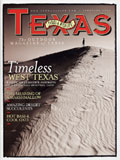
Big Bend Lore
The American West meets Mexico in the exotic area along the Rio Grande known as the Big Bend. Travelers through this fascinating land — from Frederick Olmsted in 1857 to college students on spring break in 2003 — leave with a distinct and memorable impression of the mountain peaks, desert flatlands and strange plants.
By Mary-Love Bigony
A new anthology compiles some 60 essays on Big Bend. God’s Country or Devil’s Playground (edited by Barney Nelson, University of Texas Press, $22.95 paperback, $60 hardcover) brings together well-known writers such as Aldo Leopold, Walter Prescott Webb, Edward Abbey and Roy Bedichek. In addition, there are numerous writers who are not so well-known: Robert T. Hill, head of the Texas geological survey team in 1901; Evelyn Mellard, a rancher’s wife.
Texas Parks and Wildlife Department biologist David Riskind and former TPWD commissioner Bob Burleson write about owner-built homes in rural Mexico and how they are suited for the area. Roland Wauer, former chief naturalist at Big Bend National Park, writes about the diverse wildlife in the Maderas del Carmen range. The late Barton Warnock, a leading authority on plants of the Trans-Pecos, writes of Capote Falls, the highest permanent falls in Texas.
The different points of view in this book make the Big Bend all the more intriguing. One of the most delightful quotes, from a 19th-century Mexican vaquero, is in desert survival expert David Alloway’s essay: “You go south from Fort Davis until you come to the place where the rainbows wait for rain, and the big river is kept in a stone box, and the water flows uphill. And the mountains float in the air, except at night, when they run off to play with other mountains.”

